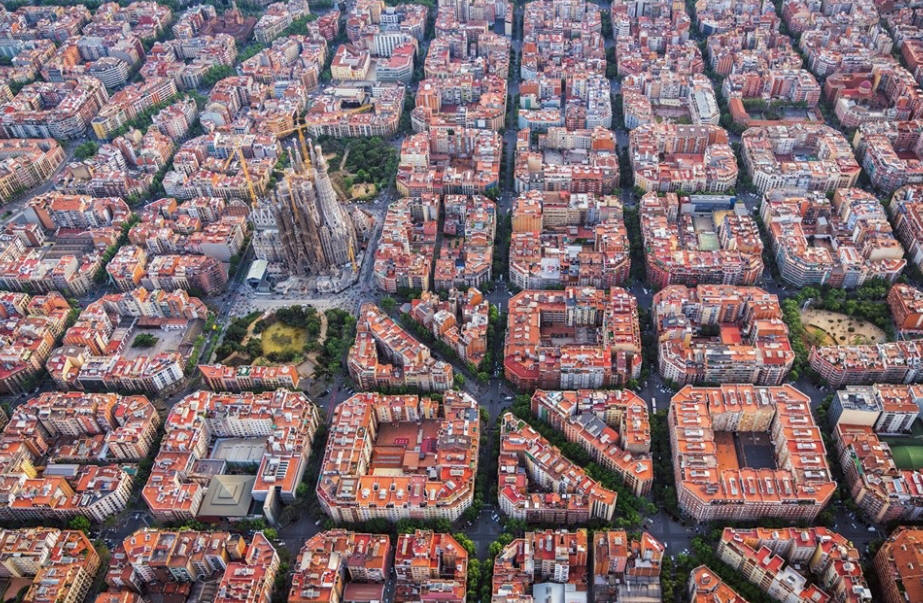Barcelona, Spain

(Click here to go back to Home Page)
Barcelona was the last stop of our 13 day transatlantic cruise from Ft. Lauderdale. After arriving, we went directly to the Barcelona airport for a flight to Rome, Italy. We spent three nights in Rome, then flew back to Barcelona. One night in Barcelona and then it was the beginning of another 13 day cruise along the Mediterranean.
Sagrada Família
The Basílica i Temple Expiatori de la Sagrada Família (English: Basilica and Expiatory Church of the Holy Family), is a large Roman Catholic church in Barcelona, Spain, designed by Catalan architect Antoni Gaudí (1852–1926). Although incomplete, the church is a UNESCO World Heritage Site and in November 2010 Pope Benedict XVI consecrated and proclaimed it a minor basilica, as distinct from a cathedral which must be the seat of a bishop.
Construction of Sagrada Família had commenced in 1882 and Gaudí
became involved in 1883, taking over the project and
transforming it with his architectural and engineering style,
combining Gothic and curvilinear Art Nouveau forms. Gaudí
devoted his last years to the project, and at the time of his
death at age 73 in 1926 less than a quarter of the project was
complete.
Sagrada Família's construction progressed slowly, as it relied
on private donations and was interrupted by the Spanish Civil
War, only to resume intermittent progress in the 1950s.
Construction passed the midpoint in 2010 with some of the
project's greatest challenges remaining and an anticipated
completion date of 2026, the centenary of Gaudí's death.
The basílica has a long history of dividing the citizens of
Barcelona: over the initial possibility it might compete with
Barcelona's cathedral, over Gaudí's design itself, over the
possibility that work after Gaudí's death disregarded his
design, and the recent proposal to build an underground tunnel
of Spain's high-speed rail link to France which could disturb
its stability.
.jpg)
.jpg)
.jpg)
.jpg)
.jpg)
.jpg)
.jpg)
.jpg)
.jpg)
.jpg)
.jpg)
.jpg)
.jpg)
.jpg)
.jpg)
.jpg)
.jpg)
.jpg)
.jpg)
.jpg)
.jpg)
.jpg)
.jpg)
.jpg)
.jpg)
.jpg)
.jpg)
.jpg)
.jpg)
.jpg)
.jpg)
.jpg)
.jpg)
.jpg)
.jpg)
.jpg)
.jpg)
.jpg)
.jpg)
.jpg)
.jpg)
.jpg)
.jpg)
.jpg)
.jpg)
.jpg)
.jpg)
.jpg)
.jpg)
.jpg)
.jpg)
.jpg)
.jpg)
.jpg)
.jpg)
.jpg)
.jpg)
.jpg)
.jpg)
.jpg)
________________________________________
The Mercat de Sant
Josep de la Boqueria, often simply referred to as
La Boqueria, is a large public
market in the Ciutat Vella district of Barcelona, Catalonia,
Spain and one of the city's foremost tourist landmarks, with an
entrance from La Rambla, not far from the Liceu, Barcelona's
opera house. The market has a very diverse selection of goods.
The first mention of the Boqueria market in Barcelona dates from
1217, when tables were installed near the old city gate to sell
meat. From December 1470 onwards, a pig market was held at this
site; at this time it was known as Mercat Bornet. Later, until
1794, it was known simply as Mercat de la Palla, or straw
market. In the beginning, the market was not enclosed and had no
official status, being regarded simply as an extension of the
Plaça Nova market, which extended to the Plaça del Pi.
Later, the authorities decided to construct a separate market on
La Rambla, housing mainly fishmongers and butchers. It was not
until 1826 that the market was legally recognized, and a
convention held in 1835 decided to build an official structure.
Construction began on March 19, 1840 under the direction of the
architect Mas Vilà. The market officially opened in the same
year, but the plans for the building were modified many times.
The inauguration of the structure finally took place in 1853. A
new fish market opened in 1911, and the metal roof that still
exists today was constructed in 1914.
.jpg)
.jpg)
.jpg)
.jpg)
.jpg)
.jpg)
.jpg)
.jpg)
.jpg)
.jpg)
.jpg)
.jpg)
.jpg)
.jpg)
.jpg)
.jpg)
.jpg)
.jpg)
.jpg)
.jpg)
.jpg)
.jpg)
.jpg)
.jpg)
.jpg)
.jpg)
.jpg)
.jpg)
.jpg)
.jpg)
.jpg)
.jpg)
.jpg)
.jpg)
.jpg)
.jpg)
.jpg)
.jpg)
.jpg)
.jpg)
.jpg)
.jpg)
.jpg)
.jpg)
.jpg)
.jpg)
.jpg)
_____________________________________________________________________
La Rambla is a street in central Barcelona, popular with tourists and locals alike. A tree-lined pedestrian mall, it stretches for
1.2 kilometres (0.75 mi) connecting Plaça de Catalunya in the centre with the Christopher Columbus Monument at Port Vell.
La Rambla can be crowded, especially during the height of the tourist season. Its popularity with tourists has affected the character of the street, with a move to pavement cafes and souvenir kiosks.
.jpg)
.jpg)
.jpg)
.jpg)
.jpg)
.jpg)
.jpg)
.jpg)
.jpg)
.jpg)
.jpg)
.jpg)
.jpg)
______________________
.jpg)
.jpg)
.jpg)
.jpg)
.jpg)
.jpg)
.jpg)
.jpg)
Leaving Barcelona on another ship
.jpg)
.jpg)